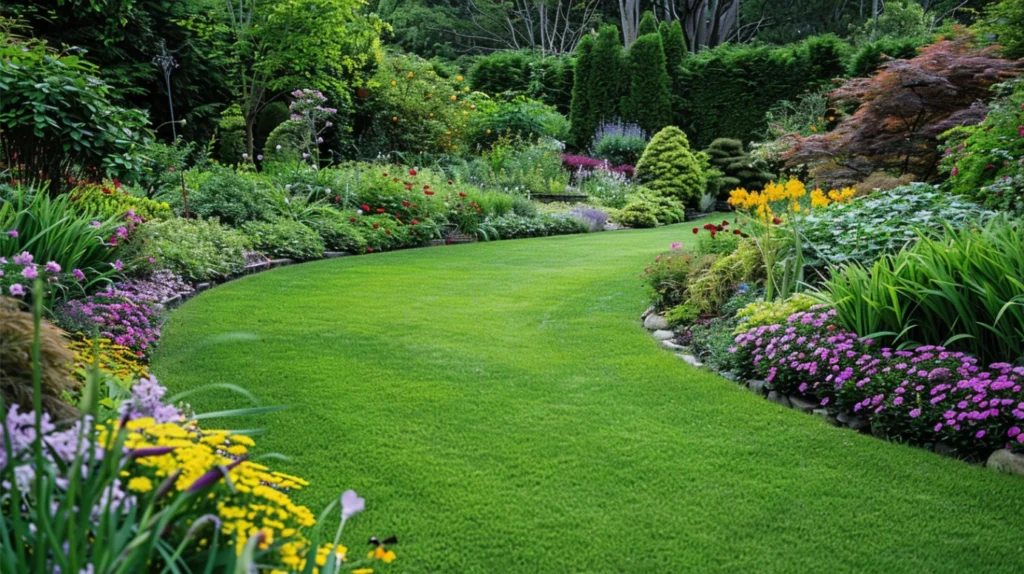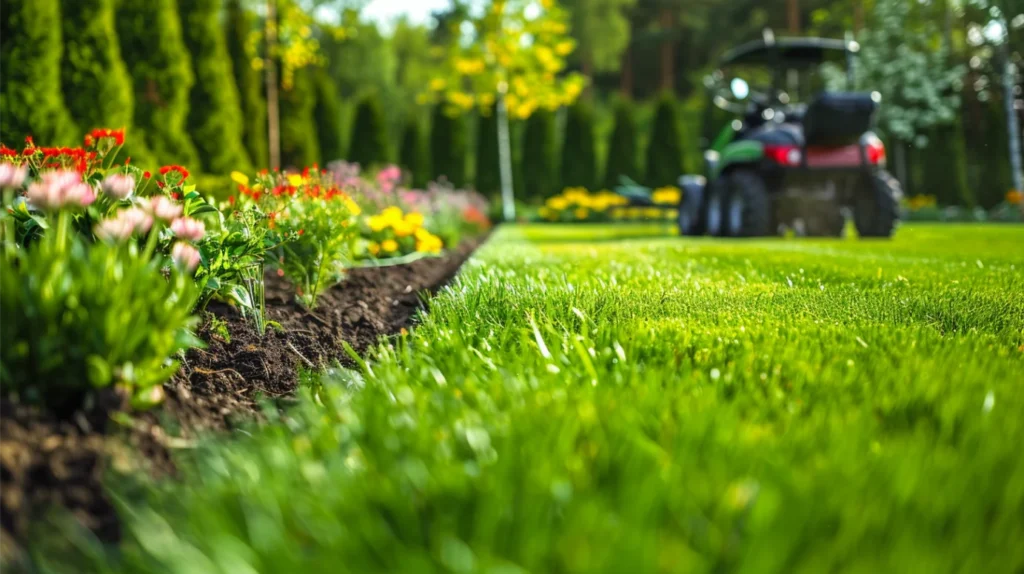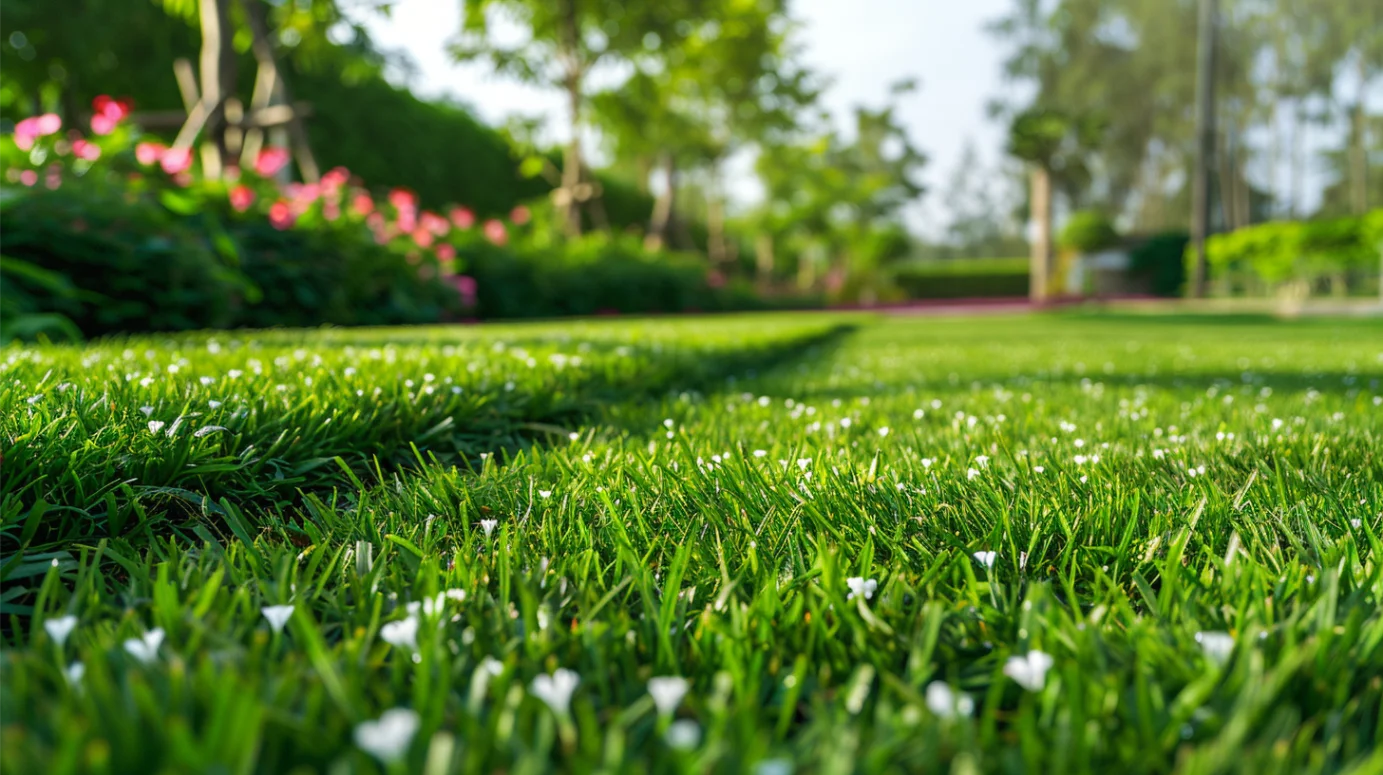Are you dreaming of a lawn that looks like it’s been plucked straight from a home and garden magazine? You’re not alone! Many homeowners aspire to have that perfect, emerald-green carpet of grass that makes neighbors stop and stare. But achieving and maintaining a picture-perfect yard doesn’t have to be a full-time job or break the bank.
Welcome to your comprehensive guide on lawn care hacks that will transform your outdoor space into the envy of the neighborhood. Whether you’re a seasoned green thumb or a novice just starting to explore the world of lawn care, this article is packed with valuable tips, tricks, and shortcuts to help you achieve the lawn of your dreams. For even more gardening and home improvement ideas, be sure to check out https://gardenandhomehacks.com/ for a treasure trove of practical advice and innovative solutions.
Understanding Your Lawn: The Foundation of Great Yard Care

Before we dive into the specific hacks, it’s crucial to understand that a beautiful lawn starts with knowing what you’re working with. Every yard is unique, and what works for one may not work for another. Let’s break down the key factors you need to consider:
1. Grass Type
Different grass types thrive in different climates and conditions. Common types include:
- Cool-season grasses: Kentucky bluegrass, fescue, ryegrass
- Warm-season grasses: Bermuda grass, zoysia, St. Augustine
Knowing your grass type is essential for proper care, as each has specific needs for watering, mowing, and fertilizing.
2. Soil Composition
The soil in your yard plays a crucial role in lawn health. Factors to consider include:
- pH levels (ideal range is typically 6.0 to 7.0)
- Nutrient content
- Soil structure (clay, sandy, loamy)
3. Climate and Sunlight
Your local climate and the amount of sunlight your lawn receives will significantly impact its health and growth patterns.
4. Existing Lawn Issues
Identify any current problems such as:
- Bare patches
- Weed infestations
- Pest damage
- Drainage issues
By understanding these fundamental aspects of your lawn, you’ll be better equipped to implement the hacks and tips we’re about to explore. Now, let’s get into the nitty-gritty of transforming your yard into a lush, green paradise!
Mowing Magic: The Key to a Manicured Look

Proper mowing is perhaps the most crucial aspect of maintaining a picture-perfect lawn. It’s not just about cutting the grass; it’s about encouraging healthy growth and creating that crisp, well-maintained appearance. Here are some game-changing mowing hacks:
1. The One-Third Rule
Never remove more than one-third of the grass blade length in a single mowing session. This promotes stronger roots and prevents stress on the grass.
2. Alternate Mowing Patterns
Change your mowing direction each time you cut the grass. This prevents soil compaction and encourages upright growth, resulting in a more even appearance.
3. Sharpen Those Blades
Dull mower blades tear the grass instead of cutting it cleanly, leading to a brownish tint and increased susceptibility to disease. Sharpen your blades at least once a season, or more if you mow frequently.
4. Leave the Clippings
Unless they’re excessively long, leave grass clippings on the lawn after mowing. They decompose quickly, returning valuable nutrients to the soil.
5. Mow When Dry
Cutting wet grass can lead to clumping and uneven cuts. Wait for the lawn to dry before mowing for best results.
6. Adjust Mowing Height Seasonally
In summer, let your grass grow a bit taller to protect the soil from excessive heat and retain moisture. In cooler months, you can cut it shorter to prevent matting and snow mold.
By mastering these mowing techniques, you’ll be well on your way to achieving that manicured, golf-course-like appearance that turns heads.
Watering Wisdom: Quenching Your Lawn’s Thirst Efficiently

Proper watering is essential for a healthy, vibrant lawn, but it’s easy to either overwater or underwater. Here are some smart watering hacks to keep your grass hydrated without wasting water:
1. Water Deeply and Infrequently
Instead of light, frequent watering, opt for deep, infrequent watering sessions. This encourages roots to grow deeper, making your lawn more drought-resistant.
2. Time It Right
Water early in the morning, ideally between 4 am and 10 am. This reduces water loss due to evaporation and gives the grass time to dry before nightfall, preventing fungal growth.
3. Use the Tuna Can Trick
Place empty tuna cans around your lawn while watering. When they’re full, you’ve watered about an inch, which is typically sufficient for most lawns.
4. Install a Smart Irrigation System
Invest in a smart sprinkler system that adjusts watering based on weather conditions and soil moisture levels. This can save water and prevent overwatering.
5. Collect Rainwater
Set up a rainwater collection system to use for watering during dry spells. It’s eco-friendly and can save on water bills.
6. Look for Signs of Thirst
Learn to recognize when your lawn needs water:
- Footprints remain visible long after walking on the grass
- Grass blades curl or wilt
- The lawn takes on a grayish cast
By following these watering hacks, you’ll ensure your lawn stays lush and green without unnecessary water waste.
Fertilizing Finesse: Feeding Your Lawn for Optimal Growth
A well-fed lawn is a healthy lawn, and a healthy lawn is a beautiful lawn. Here’s how to fertilize like a pro:
1. Test Your Soil First
Before applying any fertilizer, conduct a soil test to determine what nutrients your lawn actually needs. This prevents over-fertilization and saves money.
2. Choose the Right Fertilizer
Based on your soil test results, select a fertilizer with the appropriate N-P-K (Nitrogen-Phosphorus-Potassium) ratio for your lawn’s specific needs.
3. Time It Right
Apply fertilizer at the right time for your grass type:
- Cool-season grasses: Early spring and fall
- Warm-season grasses: Late spring and summer
4. Use a Spreader
For even application, use a broadcast or drop spreader rather than applying by hand.
5. Water After Fertilizing
Lightly water your lawn after applying fertilizer to help it absorb into the soil and prevent burning.
6. Go Organic
Consider using organic fertilizers like compost or well-rotted manure for a more environmentally friendly approach.
7. Don’t Overfeed
More is not always better when it comes to fertilizer. Stick to the recommended application rates to avoid damaging your lawn or contributing to water pollution.
By mastering the art of fertilization, you’ll provide your lawn with the nutrients it needs to thrive and maintain that lush, green appearance year-round.
Weed Warfare: Winning the Battle Against Unwanted Plants
Nothing ruins the look of a perfect lawn quite like weeds. Here are some clever hacks to keep these invaders at bay:
1. Corn Gluten Meal Magic
Apply corn gluten meal in early spring as a natural pre-emergent herbicide. It prevents weed seeds from germinating while feeding your lawn.
2. Vinegar Spray for Spot Treatment
For isolated weeds, especially in cracks or along edges, use a vinegar spray. Mix one gallon of white vinegar with one cup of salt and a tablespoon of dish soap for a potent weed killer.
3. Boiling Water Technique
Pour boiling water directly on weeds growing in sidewalk cracks or driveway seams. It’s an eco-friendly way to kill weeds without chemicals.
4. Overseed to Crowd Out Weeds
A thick, healthy lawn is your best defense against weeds. Overseed thin areas to create a dense turf that leaves no room for weeds to take root.
5. Hand-Pulling with a Twist
When hand-pulling weeds, do it after rain or watering when the soil is moist. Use a forked tool to get the entire root system.
6. Mulch Bare Areas
Cover bare spots in your lawn with mulch until grass can grow. This prevents weeds from taking advantage of the open space.
7. Maintain Proper Mowing Height
Keeping your grass at the proper height for its type helps shade the soil, preventing weed seeds from germinating.
By implementing these weed control hacks, you’ll maintain a cleaner, more uniform lawn that truly showcases your grass.
Pest Control Prowess: Keeping Bugs and Critters at Bay
A beautiful lawn can quickly become a buffet for various pests if left unchecked. Here are some smart ways to protect your turf:
1. Nematode Allies
Introduce beneficial nematodes to your soil to combat grubs, which can devastate your lawn. These microscopic worms are a natural and effective solution.
2. Diatomaceous Earth Defense
Sprinkle food-grade diatomaceous earth around the perimeter of your lawn to deter crawling insects. It’s safe for pets and humans but lethal to many pests.
3. Bird-Friendly Yard
Encourage natural pest control by attracting birds to your yard. Install bird feeders and baths to invite these insect-eating friends.
4. Garlic Spray Solution
Create a natural pest repellent by blending garlic cloves with water and straining the mixture. Spray it on your lawn to deter various insects.
5. Coffee Grounds Barrier
Sprinkle used coffee grounds around your lawn’s edges to repel slugs and snails, which can damage grass and other plants.
6. Maintain a Healthy Lawn
Remember, a strong, well-maintained lawn is naturally more resistant to pest infestations. Proper watering, mowing, and fertilizing go a long way in pest prevention.
7. Beneficial Insects Introduction
Introduce ladybugs or praying mantises to your yard. These beneficial insects feed on many common lawn pests.
By employing these pest control strategies, you’ll protect your lawn from damage while maintaining an eco-friendly approach to yard care.
Soil Enhancement Secrets: Building a Strong Foundation
The key to a truly spectacular lawn lies beneath the surface. Enhancing your soil’s health will pay dividends in the appearance and resilience of your grass. Here are some expert hacks for improving your soil:
1. Aeration Automation
Aerate your lawn annually to reduce soil compaction and improve nutrient absorption. For smaller lawns, spike shoes can be a fun and effective DIY option.
2. Compost Tea Tonic
Brew compost tea by steeping compost in water, then use this nutrient-rich liquid to water your lawn. It’s like a superfood smoothie for your grass!
3. Biochar Boost
Incorporate biochar into your soil. This charcoal-like substance improves soil structure, increases water retention, and provides a habitat for beneficial microorganisms.
4. Mycorrhizal Fungi Friends
Introduce mycorrhizal fungi to your soil. These fungi form symbiotic relationships with grass roots, enhancing nutrient uptake and drought resistance.
5. Liquid Seaweed Solution
Apply liquid seaweed extract to your lawn. It’s rich in micronutrients and growth hormones that promote robust grass growth.
6. pH Balancing Act
Regularly test and adjust your soil’s pH. Most grasses prefer slightly acidic soil (6.0-7.0 pH). Use lime to raise pH or sulfur to lower it as needed.
7. Organic Matter Integration
Incorporate organic matter into your soil through topdressing with compost or leaving grass clippings on the lawn after mowing.
By focusing on these soil enhancement techniques, you’re setting the stage for a lawn that’s not just beautiful on the surface, but healthy and resilient from the roots up.
Eco-Friendly Lawn Care: Green Practices for a Greener Lawn
As we become more aware of our environmental impact, it’s important to consider eco-friendly approaches to lawn care. Here are some sustainable hacks that are good for your lawn and the planet:
1. Native Grass Selection
Choose grass varieties native to your region. They’re naturally adapted to local conditions, requiring less water and fewer inputs to thrive.
2. Rain Garden Integration
Create a rain garden in a low-lying area of your yard to manage runoff and filter pollutants naturally.
3. Clover Companion Planting
Introduce clover into your lawn mix. It fixes nitrogen in the soil, reducing the need for fertilizers, and stays green even during dry spells.
4. Solar-Powered Tools
Switch to solar-powered lawn care tools like mowers and trimmers to reduce your carbon footprint.
5. Grasscycling
Leave grass clippings on the lawn after mowing. They decompose quickly, returning nutrients to the soil and reducing the need for fertilizer.
6. Drought-Tolerant Landscaping
Incorporate drought-tolerant plants and grasses in parts of your yard to reduce water usage while maintaining visual appeal.
7. Natural Herbicide Alternatives
Use corn gluten meal as a pre-emergent herbicide and vinegar-based solutions for spot-treating weeds instead of chemical herbicides.
By adopting these eco-friendly practices, you’re not just creating a beautiful lawn; you’re contributing to a healthier environment overall.
Seasonal Lawn Care: Year-Round Strategies for Success
A truly picture-perfect lawn requires attention throughout the year. Each season brings its own challenges and opportunities. Here’s a seasonal breakdown of lawn care hacks:
Spring
- Rake deeply to remove thatch and dead grass.
- Overseed bare or thin patches.
- Apply pre-emergent herbicide to prevent weed growth.
- Start mowing as soon as grass begins active growth.
Summer
- Raise mowing height to protect roots from heat stress.
- Water deeply but infrequently to encourage deep root growth.
- Control pests proactively before they become a major problem.
- Spot-treat weeds as they appear.
Fall
- Aerate and dethatch to prepare for winter.
- Fertilize cool-season grasses for strong root development.
- Overseed to thicken the lawn and fill in bare spots.
- Rake leaves regularly to prevent smothering the grass.
Winter
- Minimize foot traffic on dormant or frozen grass.
- Plan and research for next year’s lawn care strategy.
- Maintain equipment like mowers and trimmers.
- Monitor for snow mold in areas prone to this winter lawn disease.
By following these seasonal guidelines, you’ll ensure your lawn looks its best year-round and is prepared for the challenges each season brings.
Troubleshooting Common Lawn Problems
Even with the best care, lawns can sometimes develop issues. Here are quick fixes for common problems:
- Brown Patches:
- Cause: Often fungal disease or pet damage
- Solution: Improve air circulation, adjust watering, or apply fungicide if necessary
- Thin Areas:
- Cause: Compacted soil, heavy shade, or poor nutrients
- Solution: Aerate, overseed, and consider shade-tolerant grass varieties
- Yellowing Grass:
- Cause: Nutrient deficiency, overwatering, or pest infestation
- Solution: Conduct a soil test and adjust care accordingly
- Moss Growth:
- Cause: Shady, moist conditions with poor drainage
- Solution: Improve drainage, reduce shade if possible, and adjust soil pH
- Uneven Growth:
- Cause: Inconsistent watering or fertilization
- Solution: Use a sprinkler system for even watering and a spreader for fertilizer application
By quickly identifying and addressing these common issues, you can maintain the health and appearance of your lawn, keeping it picture-perfect all year long.
Conclusion: Your Path to a Picture-Perfect Yard
Creating and maintaining a lawn that looks like it belongs in a magazine spread is an achievable goal with the right knowledge and techniques. By implementing these lawn care hacks, you’re well on your way to having

